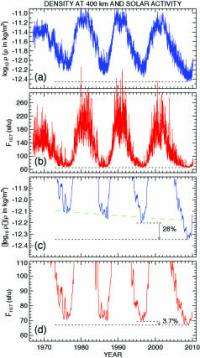(a) Daily global-average mass log-density (seasonal and geomagnetic activity effects removed) at a fiducial altitude of 400 km. The dotted horizontal line indicates the minimum overall density. (b) The daily 10.7 cm solar radio flux (F10.7) normalized to 1 AU, in solar flux units (sfu, 10-22 W m-2 Hz-1). (c) Same as (a), but showing the running 81-day average log-densities. The green dashed line shows an estimate of the trend in density for each of the first three solar minima; the final (4th) solar minimum density is 28% lower. (d) Same as (b), but showing the 81-day average F10.7. The horizontal dotted lines in (c) and (d) illustrate the differences between the cycle 23/24 and cycle 22/23 minima.
(PhysOrg.com) -- A team of scientists from the Naval Research Laboratory and George Mason University reports that the Earth's upper atmosphere has recently experienced the lowest density in 43 years. The team has published its findings in a paper entitled "Record-low thermospheric density during the 2008 solar minimum" that appeared in Geophysical Research Letters in June 2010.
The team of Dr. John Emmert and Dr. Judith Lean from NRL's Space Science Division and Dr. Michael Picone from George Mason University were studying the Earth's upper atmosphere between 200 and 600 km altitude. Although the air density at these altitudes is only about one-billionth of that at the Earth's surface, it provides sufficient drag on Low Earth Orbit (LEO) objects to cause their eventual reentry. "An operational consequence of this important new finding is that LEO satellites, including debris, may remain in orbit longer than expected," explains Emmert.
To describe their results, the researchers pointed out that the air density at orbital altitudes is ultimately linked to the temperature of the upper atmosphere. A hotter upper atmosphere will expand in vertical extent and increase the air density at a given altitude. The two major factors that control upper atmosphere temperatures are heating via absorption of ultraviolet (UV) radiation from the Sun, and cooling via CO2 infrared emission.
The Sun was unusually quiet during the prolonged solar minimum of 2007-2009, and the research team found that the associated reduction in solar UV heating can partly explain the reduction in density. Increasing concentrations of CO2 near the Earth's surface are likely making their way into the upper atmosphere and are thus increasing the upper atmosphere cooling efficiency. However, it is not yet clear whether the combination of reduced solar UV heating and enhanced CO2 cooling can fully account for the occurrence of the anomalously low thermospheric density, and the researchers suggested that changes in upper atmospheric chemistry and composition may have also contributed to the record-low density.
Provided by Naval Research Laboratory




















